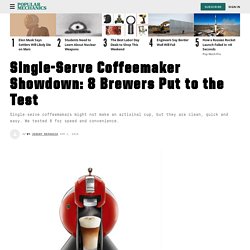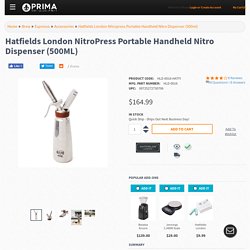

Single-Serve Coffeemaker Showdown: 8 Brewers Put to the Test. Despite the ubiquity of chain coffee shops around the country, 86 percent of coffee drinkers still brew most of their java at home, according to the National Coffee Association of USA.

But home-brewers have evolved from simple machines into high-tech appliances, some employing LCD screens, automatic milk frothers or even nitrous-oxide cartridges. The latest trend in the market has been the rising popularity of single-serve coffeemakers, with pre-measured, prepackaged pods that can fall short when it comes to taste, according to Kenneth Davids, the co-founder and editor of CoffeeReview.com. "Obviously, freshly roasted, freshly ground coffee brewed correctly is going to give a more complex and complete sensory experience as a coffee than any single-serve," he says.
While the single-serve machines may not match freshly ground coffee for taste, consumers have still flocked to them for the convenience and ease of use they offer. Keurig Special Edition Machine: $139.95 Cost per Cup: $0.56. Hatfields London NitroPress Nitro Dispenser - Prima Coffee. Hatfields has removed the necessity of tap systems and large gas canisters, which means brewing anywhere just got even more awesome.

No matter if you're at home or work, with the NitroPress you can now craft nitro cold brew and cocktails with ease. Plainly put, this handheld nitro dispenser is a whipping siphon, commonly used for carbonating, infusing, and foaming different liquids with carbon dioxide (CO2) or nitrous oxide (N2O). But what makes the NitroPress different from other whipping siphons is its unique, patented nozzle.
When dispensing, the spout functions like a stout faucet, causing a process called cavitation to occur, whereby the foam is broken up and aerated for a consistently mixed head rather than a stiff foam. While the NitroPress is capable of using either N2 or N2O cartridges, there are a couple of reasons why pure nitrogen is preferred. Using the NitroPress is super easy. What's in the box: Your Specialty Coffee Maker. 47 Tips to Make Pour Over Coffee Like a Barista. What techniques do the best baristas use to make pour over coffee?

We let the pros in our community tell you themselves. Baristas are relentless. When it comes to making pour over coffee, a true enthusiast doesn’t settle until they’ve brought out the best flavor the beans can offer. The process starts with something most of us do every morning: brewing a cup of coffee. But for a barista, this is the beginning of an experiment. A true coffee technician will analyze their pour over, tasting for imperfections and noting areas of improvement.
And again. And again, until the coffee is near perfect. The adjustments baristas make aren’t random. The 5 Best Pour Over Coffee Makers of 2016 (#4 Will Blow Your Mind) - Home Grounds. Still using the same coffee machine your parents used growing up?

If so - we need to talk. With the current renaissance happening in the Coffee industry (from beans to brewers) there is no reason you should still being using an archaic brew pot machine. The hottest trend right now is pour-over brewers (AKA hand drip or manual drip coffee makers) and with good reason; with just a little skill and know-how, you can achieve an amazing cup of coffee from the comfort of your home. First things first, though – you’ll need to know how to find the best pour over coffee maker for YOU (not for your neighbour who likes a quick coffee, not for your buddy who's into strong sharp tasting coffees, for YOU) Here's How To Choose the Best Manual Drip Coffee Maker Before you get all excited to join the pour over coffee revolution, consider the following as it will help you make the right choice, but first we need to make something crystal clear: Your Grinder is Still the Most Important Purchase!
4.
French Press. Siphon Coffee. Chemex. AeroPress. SoftBrew. Vietnamese Coffee. Turkish Coffee. Dripolator. Quick Coffee Makers. Brew Methods. Coffee Brewing Flowchart. New Brewing Methods // Research. Espresso Machines, Coffee Makers, Grinders & Tea. Coffee Pictures. Decaffeination 101: Four ways to decaffeinate coffee. Let’s begin by stating the obvious.

Caffeine occurs in coffee naturally, so any method of decaffeination (no matter how good it is) is considered by many aficionados unnatural. Some go even so far as claiming that it goes against the natural order of things. Yet there are about 10% of coffee lovers who would like to enjoy a good cup of coffee without the mild stimulating affect of caffeine. Can it be done? Can you really have a GOOD cup of coffee that has been subjected to a decaffeination process? CAVEAT EMPTOR: “decaffeinated” does not mean 100% caffeine free. What All Decaffeination Processes Have in Common Before we look at any specific decaffeination process let’s see what they share in common as a group. Coffee is always decaffeinated in its green (unroasted) state.The greatest challenge is to try to separate only the caffeine from the coffee beans while leaving the other chemicals at their original concentrations.